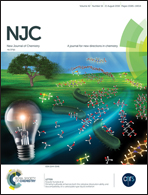An effective EMI shielding material based on poly(trimethylene terephthalate) blend nanocomposites with multiwalled carbon nanotubes†
Abstract
The effects of blend ratio and MWCNT loading on the morphology, electrical properties and electromagnetic shielding performance of poly(trimethylene terephthalate) (PTT)/polypropylene (PP) blend nanocomposites were studied. To understate the state of dispersion of the MWCNTs, PTT/PP blend nanocomposites were systematically analyzed using scanning electron microscopy and high resolution transmission electron microscopy. Fourier transform spectroscopy (FT-IR) and Raman spectroscopy techniques were used to understand the chemical interactions between the blend components and fillers. Among the nanocomposites of all blend composition with 1 wt% MWCNTs, composites with high wt% PTT (90PTT/10PP/1MWCNT) showed better electrical properties due to the double percolation phenomenon. The shielding effectiveness (SE) was investigated in the S-band frequency range and 90PTT/10PP/1MWCNT showed a very good shielding effectiveness for electromagnetic radiation. Further studies with different MWCNT loadings showed that the 90PTT/10PP blend with 5 wt% MWCNTs indicated high dielectric properties and a maximum SE of ∼40 dB. The conductivity results were linearly fitted by a power law and the obtained percolation threshold was found to be around 0.5 wt% MWCNTs. Theoretical models were also applied for the DC conductivity data to explain the conductive mechanism in the polymer blend nanocomposites.



 Please wait while we load your content...
Please wait while we load your content...